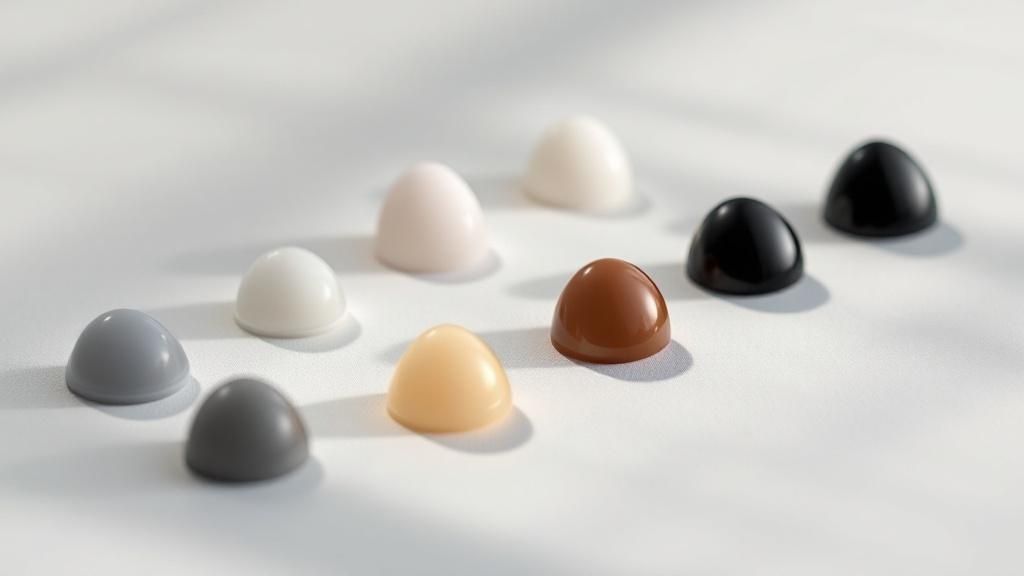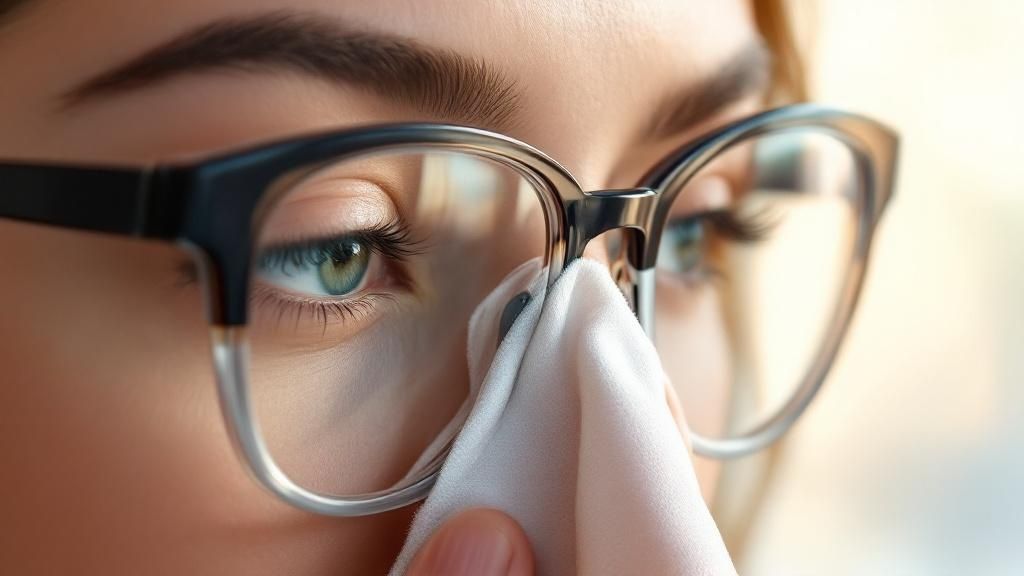Hello, Glendale Heights! We've all been there. You have a pair of glasses you love—maybe some slick Tom Fords or your trusty everyday Ray-Bans—but they just won't stay put. They're constantly sliding down your nose. It’s a common and frustrating problem, but the fix is often simpler than you think. More often than not, the culprit isn't the frames themselves, but the tiny, worn-out nose pads. For our neighbors in Glendale Heights, a quick and successful at-home glasses nose pads replacement can bring back that secure, comfortable fit you remember.
So, Why Do Your Glasses Keep Slipping?
Before you even consider shopping for new frames, let's talk about how this easy fix can make a huge difference. Whether you're driving down North Avenue or enjoying a day at the Glendale Lakes Golf Club, you need your vision to be clear and stable. A proper fit is everything; it keeps your lenses perfectly aligned with your eyes, which is essential for getting the full benefit of the prescription from your detailed eye exams in Glendale Heights.
The Unsung Heroes of Eyewear: Nose Pads
Think of nose pads as the silent workhorses of your eyeglasses. They carry the entire weight of your frames, keeping them balanced on your face and preventing the bridge from digging into your skin. But over time, they take a beating.
Here’s what happens to them:
- Material Breakdown: The natural oils from your skin, along with everyday dirt and makeup, can make soft materials like silicone get hard, turn a funky yellow color, and lose their grip.
- Losing Their Shape: Constant pressure flattens the pads, which means your glasses start sitting lower on your face than they should.
- Simple Wear and Tear: Just like the tires on a car, the constant pressure and tiny adjustments you make throughout the day eventually wear down even the toughest materials.
This is such a widespread issue that it’s created a booming market for DIY fixes. The global eyeglass repair kit market, which includes essentials like nose pads, was valued at around $200 million in 2023 and is expected to keep growing. It’s a direct result of more and more people owning glasses worldwide. You can find more details about this trend over at MarketReportAnalytics.com.
A Quick Tip From an Expert: Taking care of your eyewear is about more than just cleaning the lenses. Making it a habit to check on your nose pads and the overall frame integrity is the real secret to making them last. For more on this, take a look at our guide on how to care for your designer eyewear in Glendale Heights.
Honestly, a simple nose pad swap can make your favorite frames feel like new again. It’s a small change that ensures your glasses stay right where they belong, from your morning coffee to your evening wind-down.
Finding the Perfect Replacement Nose Pads
Before you can get to the fix, the first step in any successful glasses nose pads replacement is picking out the right parts. It's not a one-size-fits-all deal. The perfect replacement really hinges on your frame’s specific design, your personal comfort, and even the material of the pads themselves. Nailing this choice from the get-go is the secret to a hassle-free repair and a fit that feels just right.
Identify Your Frame's Mount Type
First thing's first: you need to figure out how the pads attach to your frames. There are three main systems out there, so take a close look at where your current nose pad connects to that little metal arm on your glasses.
- Screw-in Pads: This is the most common style you'll see. A tiny screw secures the pad to the frame mount. You'll spot the screw head right on the side of the pad's housing.
- Push-in (Snap-in) Pads: These are simpler. They have a small rectangular tab that just pops into a matching slot on the frame's pad arm. No screws, no fuss.
- Slide-in Pads: A bit less common, these pads slide into a grooved channel on the pad arm, usually from the top or side.
To help you visualize the best choice, here's a quick breakdown of common materials and a look at the different mounting systems.
Comparing Nose Pad Materials and Mount Types
| Feature | Silicone Pads | PVC Pads | Mounting Type Guide |
|---|---|---|---|
| Feel & Comfort | Very soft, flexible, and comfortable. | Firmer and more rigid. | Screw-in: Most common; offers a secure fit. |
| Grip | Excellent grip; prevents glasses from slipping. | Standard grip; can become slippery. | Push-in: Easiest to install; no tools needed. |
| Durability | Can yellow over time; needs regular cleaning. | More durable and easier to clean. | Slide-in: Less common; requires a specific pad shape. |
| Best For | Active individuals or those with sensitive skin. | Standard, everyday frames. | Match your new pad type to your old one. |
Choosing the right combination of material and mount is key to a comfortable, long-lasting repair.
Don't Forget Material and Size
Once you've identified the mount type, the next decision is the material. Silicone pads are a crowd favorite for a reason—they’re soft, grippy, and incredibly flexible, which is a game-changer if your glasses tend to slide down your nose. On the other hand, PVC pads are a bit firmer and more durable, often the standard issue on many frames.
When comfort is your top priority, soft silicone pads are almost always the best choice. From my experience helping clients at our Glendale Heights boutique, I can tell you they do a much better job of conforming to the bridge of your nose and getting rid of those pesky pressure points.
Finally, you have to get the size right. Nose pads are measured in millimeters (mm) from top to bottom. The simplest way to guarantee a perfect fit is to measure your old pads before you toss them. This little step ensures your glasses will sit at the exact same height on your face as they did before.
Getting these small details right is the foundation of a great fit. If you want to learn more about what makes glasses work for you, take a look at our guide on how to choose eyeglasses that truly fit your life and style. Trust me, it makes all the difference.
Gathering Your Essential Repair Tools
Thankfully, you don't need a full-blown workshop to replace your glasses' nose pads. A clean, well-lit surface and just a couple of simple tools are all it takes to get the job done correctly and without any drama.
The star of the show is a standard eyeglass repair kit. You can find these just about anywhere, and they usually come with everything you'll need for this quick fix.
What’s Inside a Good Repair Kit?
When you open up your kit, you should find a few specific items that make this process go smoothly and keep you from accidentally scratching your frames or losing a tiny screw.
- Precision Screwdriver: This is the most critical tool. It's a tiny screwdriver, sometimes with swappable flat-head and Phillips-head bits, designed specifically for the minuscule screws holding your glasses together.
- Tweezers: Don't underestimate these! Tweezers are your best friend for securely gripping and maneuvering those impossibly small screws.
- Microfiber Cloth: An absolute must for cleaning the frame and the new pads. Using anything else risks leaving behind lint or, even worse, scratching your lenses.
My Go-To Trick: Before you even think about touching a screw, lay down a soft towel or cloth on your workspace. This creates a non-slip surface and, more importantly, it's a lifesaver if you drop a screw—it won't bounce away into oblivion.
Knowing what to have on hand is just as important as the repair itself. For more advice on being prepared for all your vision needs, take a look at our guide on the five essential questions to ask your optometrist during an eye exam in Glendale Heights.
Your Guide to Replacing Eyeglass Nose Pads
https://www.youtube.com/embed/DGGfM8WqVd0
Alright, you've got your tools and new nose pads laid out. Now for the main event: swapping out those old, worn-out pads for fresh new ones. The exact method will change a little depending on whether your glasses have screw-in or push-in pads, but don't worry—either way, it’s a job you can definitely handle at home.
This quick visual guide breaks down the essential steps for getting your glasses back in top shape.
It really boils down to three simple actions: pop the old one out, put the new one in, and make sure it feels right.
Tackling Screw-In Nose Pads
For frames with screw-in pads, your precision screwdriver is the star of the show. Hold your glasses firmly and turn the tiny screw counter-clockwise.
Here's a tip from someone who's dropped these screws more times than I can count: use a magnetized screwdriver if you have one. It makes all the difference in keeping that minuscule screw from vanishing into the carpet.
Once the screw is out, the old pad comes right off. Line up the new one—and double-check that it's facing the right way. Some pads are shaped specifically for the left or right side. Then, just thread the screw back in and tighten it until it’s snug. Be careful not to overtighten and strip the screw.
Handling Push-In and Slide-In Types
If you have push-in or slide-in pads, your job is even easier. Grip the pad arm securely with one hand and the pad itself with the other. A gentle but firm pull, maybe with a little wiggle, should do the trick. Just be mindful not to bend the metal arm.
To install the new one, simply align it with the mount and push it on until you feel a satisfying little click. That's how you know it's locked in place.
A Quick Tip from an Expert: Changing your nose pads isn't just about comfort; it's also a matter of hygiene. The materials have come a long way, with modern silicone and soft rubber pads offering a much better grip and feel. I always tell my clients to plan on replacing them every 6 to 12 months to keep their glasses feeling clean and fitting perfectly.
Following these steps should give you the confidence to repair your favorite designer eyeglasses in Glendale Heights without worrying about causing any damage. With your new pads installed, you might find yourself noticing other little annoyances, like foggy lenses. For that common winter woe, be sure to read our guide on how to stop your glasses from fogging up in winter.
Troubleshooting and Fine-Tuning for a Perfect Fit
So, you’ve successfully swapped out your old nose pads for new ones. Great job! But sometimes, even with a successful replacement, the fit might feel just a little… off. Don't sweat it. Most of these small issues are simple to fix with a gentle hand and a bit of patience. Think of this as your go-to guide for getting that "just right" feeling.
One common hiccup is a screw that just won't cooperate. If you find one that’s stubbornly stuck, the last thing you want to do is force it and risk stripping the screw or damaging your frames. A better approach is to apply a single, tiny drop of penetrating oil (like WD-40) right on the screw head. Let it work its magic for a minute or so to loosen any gunk or corrosion, then give it another gentle try.
Fine-Tuning for Comfort
What if the new pads—especially the push-in kind—feel a bit wobbly? This happens all the time. The fix is usually a micro-adjustment to the metal pad arm that holds the pad itself.
- If the fit is too loose: Use your thumb to gently nudge the pad arms a tiny bit closer together.
- If the fit is too tight: Use your index finger to carefully push the pad arms slightly further apart.
A Quick Check for Perfect Alignment: After you've got the new pads on and they feel secure, pop your glasses on and take a look in the mirror. They should sit straight across your face, and the pressure on your nose should feel light and balanced. If one side seems higher than the other, it might be time for a professional adjustment.
The style of your frames plays a surprisingly big role here. Take square and rectangular frames, for example. They make up roughly 53% of all eyewear inventory and their geometric design often demands very precise nose pad placement to feel right. Keeping these popular styles comfortable means staying on top of maintenance. You can dig into more eyewear industry statistics to see just how prevalent these trends are.
If you’ve tried these little tweaks and your glasses still feel crooked, or if you're feeling any pinching or discomfort, that’s your cue to bring in an expert. A quick visit to a professional, like your local eye doctor in Glendale Heights, can get things sorted out safely and have your glasses feeling perfect in no time.
When to Visit Your Local Glendale Heights Optician
While swapping out your own nose pads is a perfectly doable task for most people, there are definitely times when it’s smarter to let a professional handle it. It's one thing to replace a small part, but it's another thing entirely to fix the frame itself.
Think of it this way: if the little metal arm that holds the nose pad is bent, broken, or feels wobbly and fragile, stop right there. Trying to bend it back yourself is a classic recipe for snapping it clean off, which turns a simple fix into a much bigger, more expensive problem.
Special Cases and When to Get Help
You'll also want to pause if you're working with high-end designer frames. Brands like Cartier or Gucci often use unique, custom-made parts that you just won't find in a standard replacement kit. Attempting a DIY repair on these could easily damage your investment.
The most telling sign you need professional help? You’ve successfully replaced the pads, but your glasses still feel crooked, slip down your nose, or just don't sit right. This means the issue isn't the pads—it's the frame alignment. An unbalanced frame can mess with your vision and cause headaches, and that's something only an expert can truly fix.
At iDoctor in Glendale Heights, we see this all the time and perform expert repairs and adjustments every day. We're here to make sure you get the absolute best vision and comfort out of your eyewear.
Just as frame maintenance is crucial, so is keeping up with your eye health. Knowing how often you should get an eye exam is fundamental. If you're having any trouble with your designer eyeglasses, please don't hesitate to stop by—we’re here to help.
FAQ: Your Top Nose Pad Questions
When you live with glasses every day, you start to notice the little things. Here are some of the questions we hear all the time at our Glendale Heights shop about keeping your frames feeling brand new.
How often should I replace my glasses nose pads?
We usually recommend replacing your nose pads every 6 to 12 months. Over time, skin oils and daily wear can cause them to harden, yellow, and lose their grip. A quick glasses nose pads replacement is one of the easiest ways to make your eyewear feel fresh, clean, and secure again.
Where can I find replacement nose pads for my Cartier glasses near me?
For luxury brands like Cartier, Gucci, or Tom Ford, it's best to visit a professional optician. At iDoctor in Glendale Heights, we can help source authentic replacement parts and ensure they are fitted perfectly without damaging your high-end frames. Stop by our boutique and we’ll be happy to assist you.
Will new nose pads stop my glasses from sliding down my nose?
For most people, yes! Slipping is often a sign that the old nose pads have become hard and slick. Swapping them for new, soft silicone pads restores that essential grip. If your glasses still slide after a replacement, the issue is likely the overall frame fit, which requires a professional adjustment from your best optometrist in Glendale Heights.
At iDoctor, we're passionate about two things: perfect vision and eyewear that you love to wear. Whether you need a quick adjustment after a drive down Bloomingdale Road or are ready to find your next favorite pair of designer glasses, our team in Glendale Heights is ready to help.
Explore our eyewear collections and book your eye exam today!









